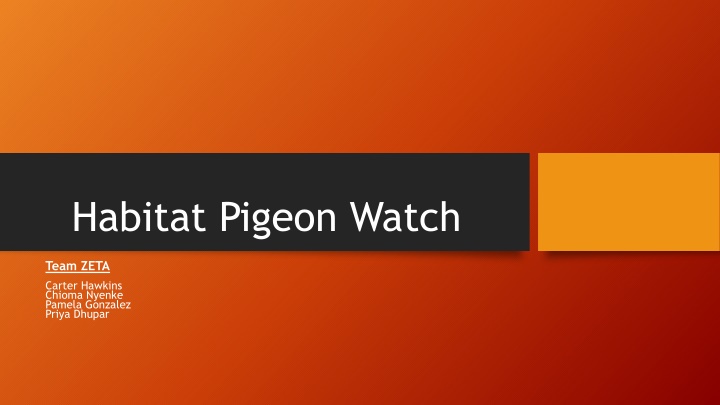
Natural Selection in Local Pigeon Populations
This study aims to investigate natural selection in local pigeon communities by observing varying morphs in different habitats. By analyzing data and considering prior research, the team found a significant link between habitat types and pigeon morph diversity, hinting at ongoing evolutionary processes.
Download Presentation

Please find below an Image/Link to download the presentation.
The content on the website is provided AS IS for your information and personal use only. It may not be sold, licensed, or shared on other websites without obtaining consent from the author. If you encounter any issues during the download, it is possible that the publisher has removed the file from their server.
You are allowed to download the files provided on this website for personal or commercial use, subject to the condition that they are used lawfully. All files are the property of their respective owners.
The content on the website is provided AS IS for your information and personal use only. It may not be sold, licensed, or shared on other websites without obtaining consent from the author.
E N D
Presentation Transcript
Habitat Pigeon Watch Team ZETA Carter Hawkins Chioma Nyenke Pamela Gonzalez Priya Dhupar
Introduction The purpose of our study is to determine if natural selection is at play in our local communities. We will use pigeons for observations because they are the best-known animal to the public and easily accessible. Other advantages to observing pigeons include: clear varying morphs and they are susceptible to predation from city threats like larger birds or cats Our early predictions: natural selection is present in the observed flocks. We do believe there will be a difference in the mix of morphs with the mixes of habitats. The most common and original morph of pigeon is the blue bar, which in theory should be the dominant morph if natural and stabilizing selection is occurring.
Introduction (contd.) Definitions: Natural selection - the gradual process of species that are better adapted and fit to their environment, being able to live longer and therefore produce more offspring Stabilizing selection - occurs when natural selection happens and as a result the most noticeable morph or morphs to predators are killed off by predators leaving the original morph to be the dominant type in the flock.
Background A study done by UC Santa Cruz examined 2 types of pigeons (one type last known to live in 1914) in which researchers stated, "When we looked at rates of adaptive evolution and purifying selection in both species, we found evidence that natural selection had resulted in both a faster rate of adaptive evolution (Stephens, 1). Breaking news: Pigeons are not new to the process! In LaBranche's article, Why Study Pigeons? he states, No other feral animal has kept its domestic colors for more than a few generations why, then, aren t feral pigeons all blue-bars? (Labranche, 1). The question has always been, why are blue bar pigeons not the dominant morph?
Methods Where to Find Pigeons What we looked for How we recorded the data
Discussion & Conclusion With the 20 years worth of data from our predecessors in combination with the data we collected, we were able to calculate and analyze that data to find that there was a significant difference between habitat and pigeon morphs Our findings rejected the null hypothesis, meaning that stabilizing selection is at play in our local communities, and that our original hypothesis was correct
